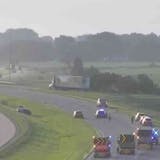DULUTH – Minnesotans quoted Theodore Roosevelt, advocated for the blue-spotted salamander and invoked God as they spoke from their hearts to a panel of federal officials Thursday about the economic promise of mining and its threats to the state's northern forests and lakes.
The evening meeting at the Duluth Entertainment and Convention Center drew about 1,000 people. It marked the start of a two-year environmental impact investigation that will determine whether the federal government will ban copper-nickel mining for two decades in the Superior National Forest near the Boundary Waters Canoe Area Wilderness and Voyageurs National Park.
Blue-hatted mine supporters sat on one side of the auditorium, with sign-bearing lovers of the BWCA on the other. Drawn at random in a lottery, speakers got up one by one. Each spoke for three minutes along lines that have divided the state for a decade.
"Mining is what we do for a living," said St. Louis County Commissioner Tommy Rukavina. "It's what we've done for 135 years and you people get to come up to the wilderness that we've taken care of."
Those on the other side said copper-nickel mining is not the same as the taconite and iron ore mining that have long been the economic backbone of northern Minnesota.
Waste from the mining of sulfide ore produces an acid that would leach toxic metals and other contaminants into water flowing into the BWCA and the national park. Similar mines have contaminated thousands of miles of streams across the United States, and often require perpetual water treatment to remove contaminants.
"Sulfide mining in that watershed will wreck thousands of outdoor sustainable jobs for short-term benefit," said Eric Jensen of Backcountry Hunters & Anglers, a national group dedicated to advocating for public lands.
The stakes are high
In December, the federal Bureau of Land Management and the U.S. Forest Service announced a two-year moratorium on mineral exploration on federal lands near the BWCA. That will give the agencies time to conduct an environmental impact review driven by the significant risks to the wilderness and the national park.



